PUBH6007 Report: Program Evaluation and Obesity Prevention Strategies
VerifiedAdded on 2022/09/07
|11
|1002
|15
Report
AI Summary
This report details a program plan designed to address the issue of obesity within the Indigenous Australian population. The program aims to increase awareness of the health risks associated with unhealthy lifestyles and provides strategies to promote healthier living. The plan includes specific objectives, such as identifying the causes of obesity and collecting data to inform strategy development. Strategies focus on child and women's care, reducing low birth weight babies, managing diabetic pregnancies, and controlling infectious diseases. Dietary recommendations emphasize whole grains, lean meats, fresh fruits, and traditional foods. The report also outlines potential risks and challenges, including premature death, increased rates of diabetes and renal disease, and the importance of resources to implement the program. References from various research papers are included to support the program's strategies.
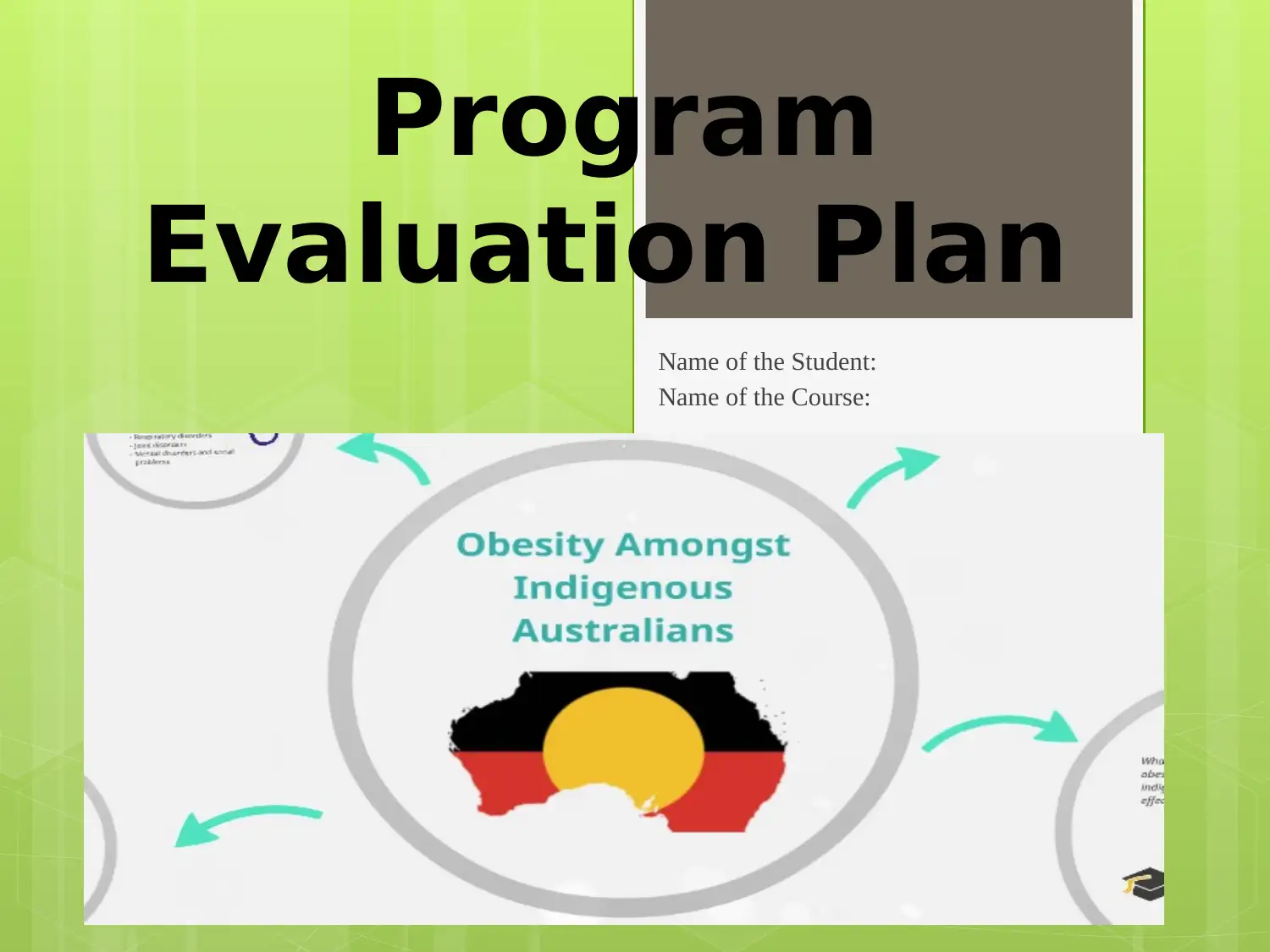
Name of the Student:
Name of the Course:
Program
Evaluation Plan
Name of the Course:
Program
Evaluation Plan
Paraphrase This Document
Need a fresh take? Get an instant paraphrase of this document with our AI Paraphraser
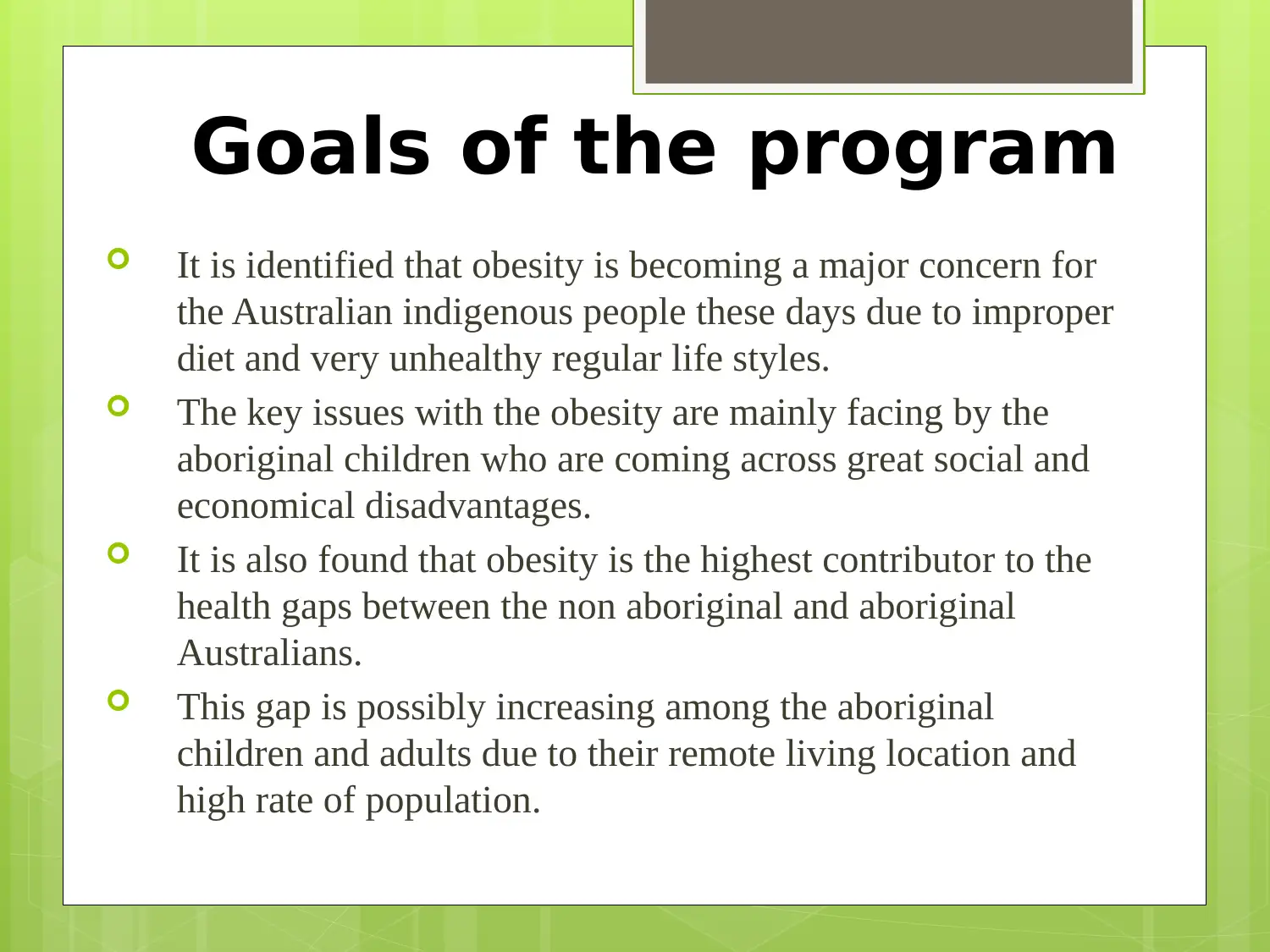
Goals of the program
It is identified that obesity is becoming a major concern for
the Australian indigenous people these days due to improper
diet and very unhealthy regular life styles.
The key issues with the obesity are mainly facing by the
aboriginal children who are coming across great social and
economical disadvantages.
It is also found that obesity is the highest contributor to the
health gaps between the non aboriginal and aboriginal
Australians.
This gap is possibly increasing among the aboriginal
children and adults due to their remote living location and
high rate of population.
It is identified that obesity is becoming a major concern for
the Australian indigenous people these days due to improper
diet and very unhealthy regular life styles.
The key issues with the obesity are mainly facing by the
aboriginal children who are coming across great social and
economical disadvantages.
It is also found that obesity is the highest contributor to the
health gaps between the non aboriginal and aboriginal
Australians.
This gap is possibly increasing among the aboriginal
children and adults due to their remote living location and
high rate of population.
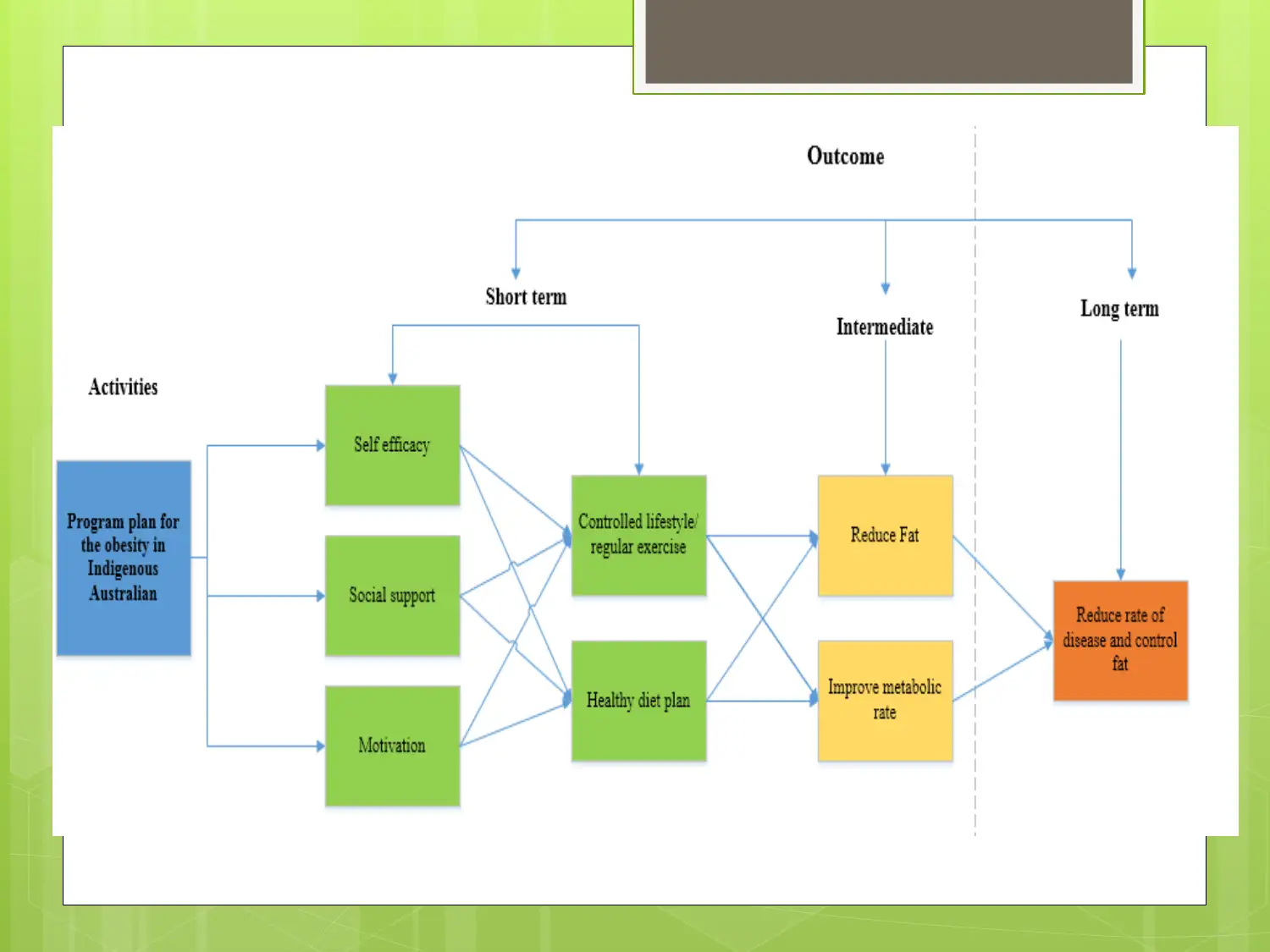
⊘ This is a preview!⊘
Do you want full access?
Subscribe today to unlock all pages.

Trusted by 1+ million students worldwide
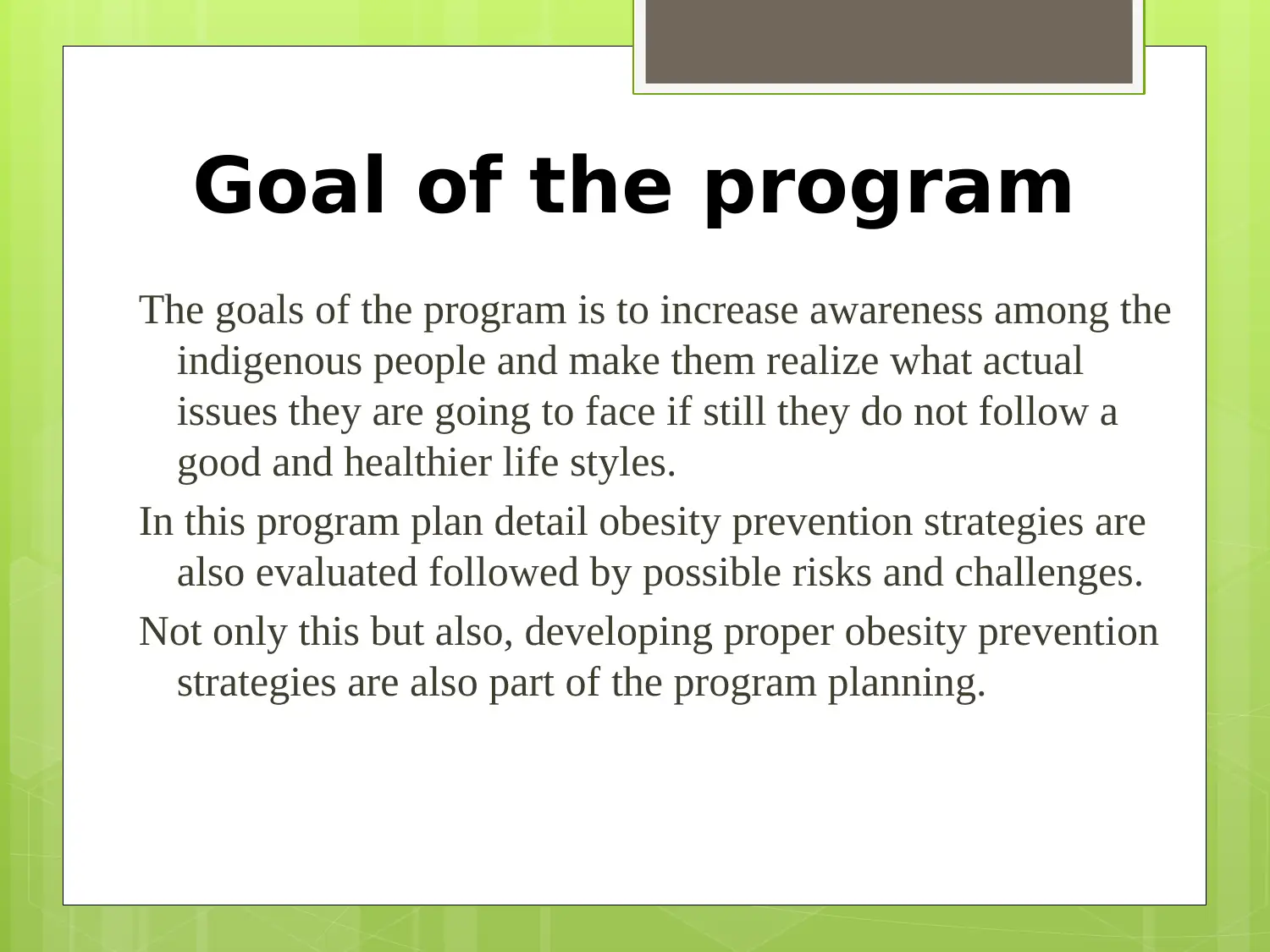
Goal of the program
The goals of the program is to increase awareness among the
indigenous people and make them realize what actual
issues they are going to face if still they do not follow a
good and healthier life styles.
In this program plan detail obesity prevention strategies are
also evaluated followed by possible risks and challenges.
Not only this but also, developing proper obesity prevention
strategies are also part of the program planning.
The goals of the program is to increase awareness among the
indigenous people and make them realize what actual
issues they are going to face if still they do not follow a
good and healthier life styles.
In this program plan detail obesity prevention strategies are
also evaluated followed by possible risks and challenges.
Not only this but also, developing proper obesity prevention
strategies are also part of the program planning.
Paraphrase This Document
Need a fresh take? Get an instant paraphrase of this document with our AI Paraphraser
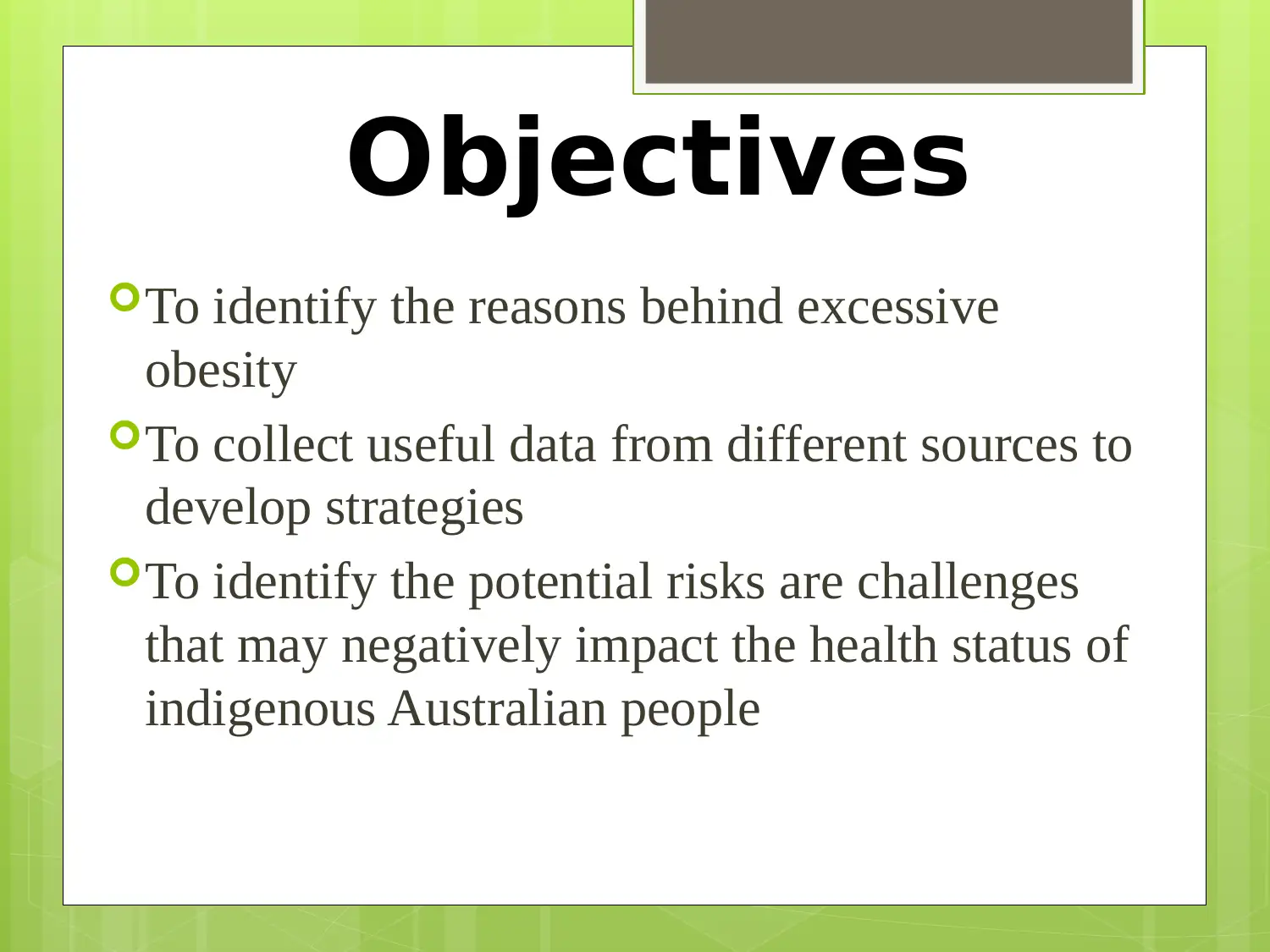
Objectives
To identify the reasons behind excessive
obesity
To collect useful data from different sources to
develop strategies
To identify the potential risks are challenges
that may negatively impact the health status of
indigenous Australian people
To identify the reasons behind excessive
obesity
To collect useful data from different sources to
develop strategies
To identify the potential risks are challenges
that may negatively impact the health status of
indigenous Australian people
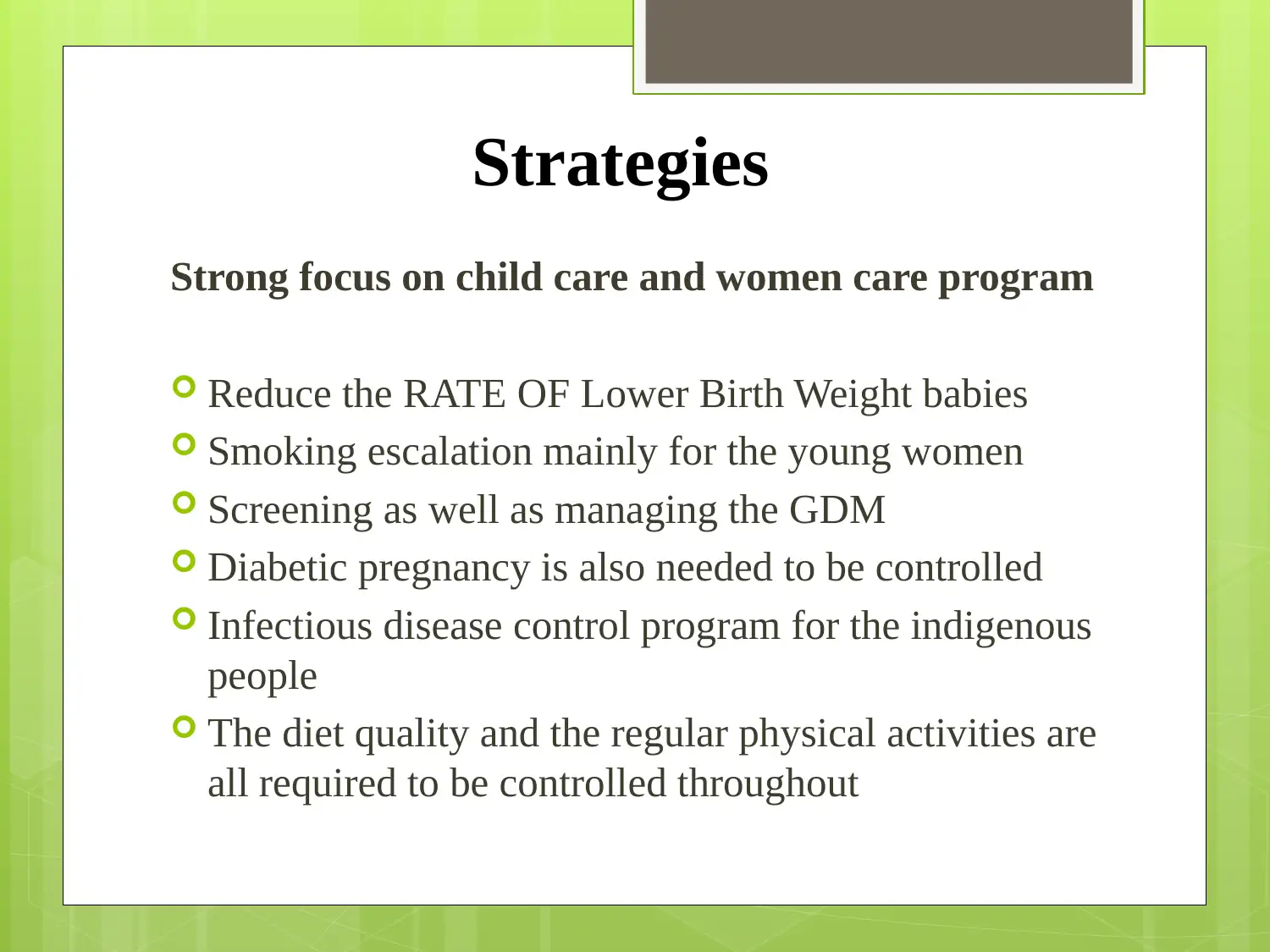
Strategies
Strong focus on child care and women care program
Reduce the RATE OF Lower Birth Weight babies
Smoking escalation mainly for the young women
Screening as well as managing the GDM
Diabetic pregnancy is also needed to be controlled
Infectious disease control program for the indigenous
people
The diet quality and the regular physical activities are
all required to be controlled throughout
Strong focus on child care and women care program
Reduce the RATE OF Lower Birth Weight babies
Smoking escalation mainly for the young women
Screening as well as managing the GDM
Diabetic pregnancy is also needed to be controlled
Infectious disease control program for the indigenous
people
The diet quality and the regular physical activities are
all required to be controlled throughout
⊘ This is a preview!⊘
Do you want full access?
Subscribe today to unlock all pages.

Trusted by 1+ million students worldwide
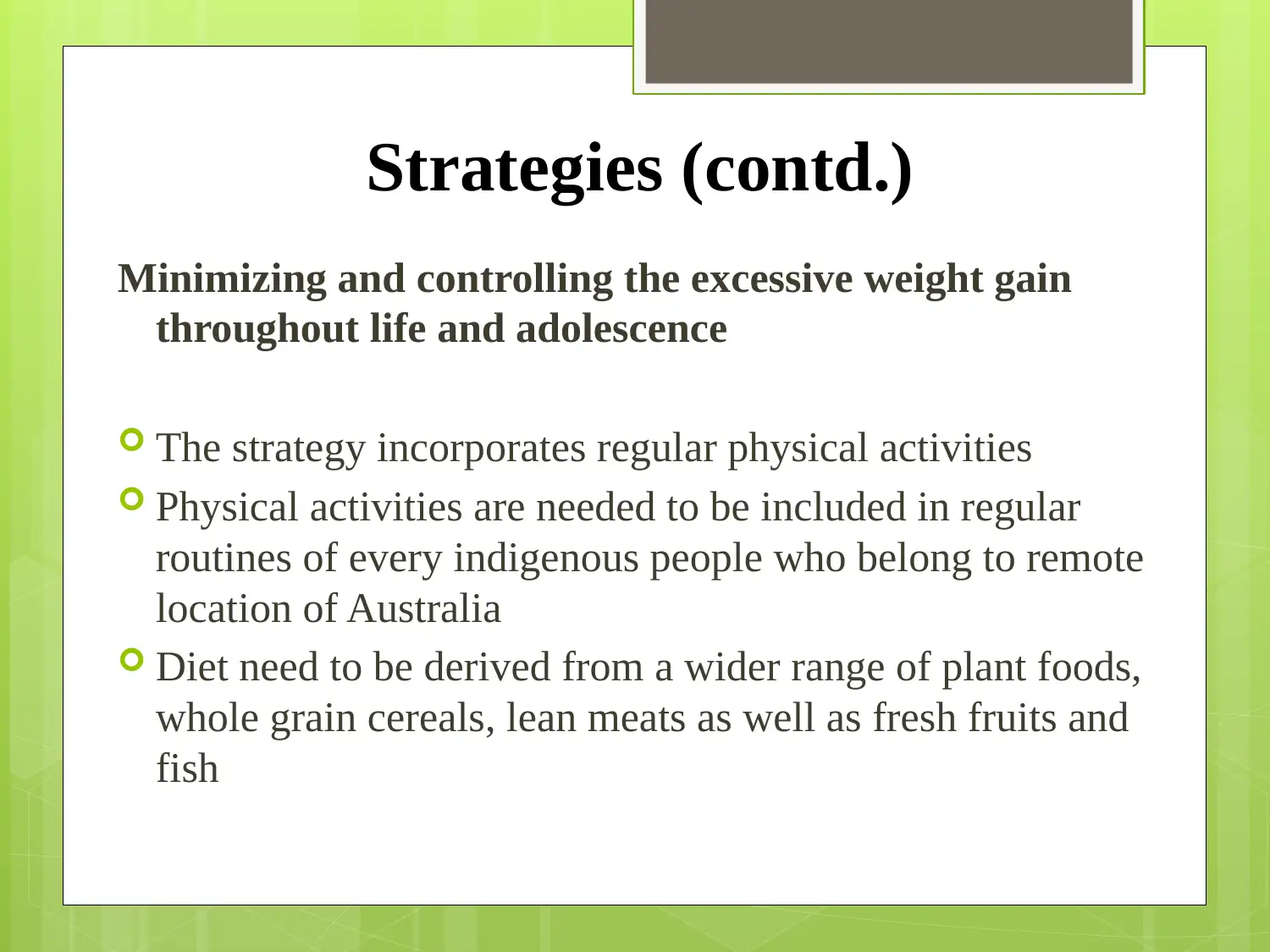
Strategies (contd.)
Minimizing and controlling the excessive weight gain
throughout life and adolescence
The strategy incorporates regular physical activities
Physical activities are needed to be included in regular
routines of every indigenous people who belong to remote
location of Australia
Diet need to be derived from a wider range of plant foods,
whole grain cereals, lean meats as well as fresh fruits and
fish
Minimizing and controlling the excessive weight gain
throughout life and adolescence
The strategy incorporates regular physical activities
Physical activities are needed to be included in regular
routines of every indigenous people who belong to remote
location of Australia
Diet need to be derived from a wider range of plant foods,
whole grain cereals, lean meats as well as fresh fruits and
fish
Paraphrase This Document
Need a fresh take? Get an instant paraphrase of this document with our AI Paraphraser
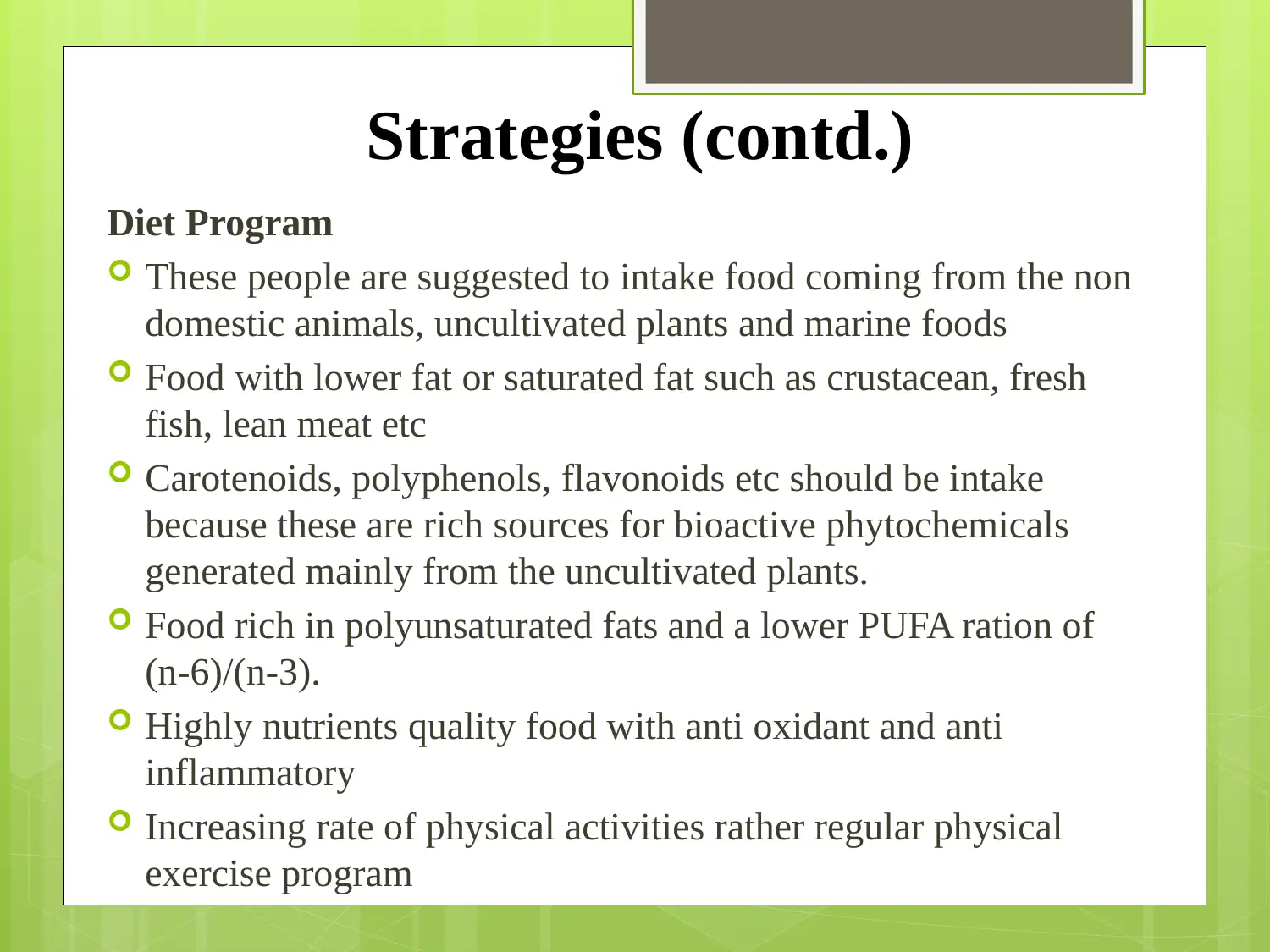
Strategies (contd.)
Diet Program
These people are suggested to intake food coming from the non
domestic animals, uncultivated plants and marine foods
Food with lower fat or saturated fat such as crustacean, fresh
fish, lean meat etc
Carotenoids, polyphenols, flavonoids etc should be intake
because these are rich sources for bioactive phytochemicals
generated mainly from the uncultivated plants.
Food rich in polyunsaturated fats and a lower PUFA ration of
(n-6)/(n-3).
Highly nutrients quality food with anti oxidant and anti
inflammatory
Increasing rate of physical activities rather regular physical
exercise program
Diet Program
These people are suggested to intake food coming from the non
domestic animals, uncultivated plants and marine foods
Food with lower fat or saturated fat such as crustacean, fresh
fish, lean meat etc
Carotenoids, polyphenols, flavonoids etc should be intake
because these are rich sources for bioactive phytochemicals
generated mainly from the uncultivated plants.
Food rich in polyunsaturated fats and a lower PUFA ration of
(n-6)/(n-3).
Highly nutrients quality food with anti oxidant and anti
inflammatory
Increasing rate of physical activities rather regular physical
exercise program
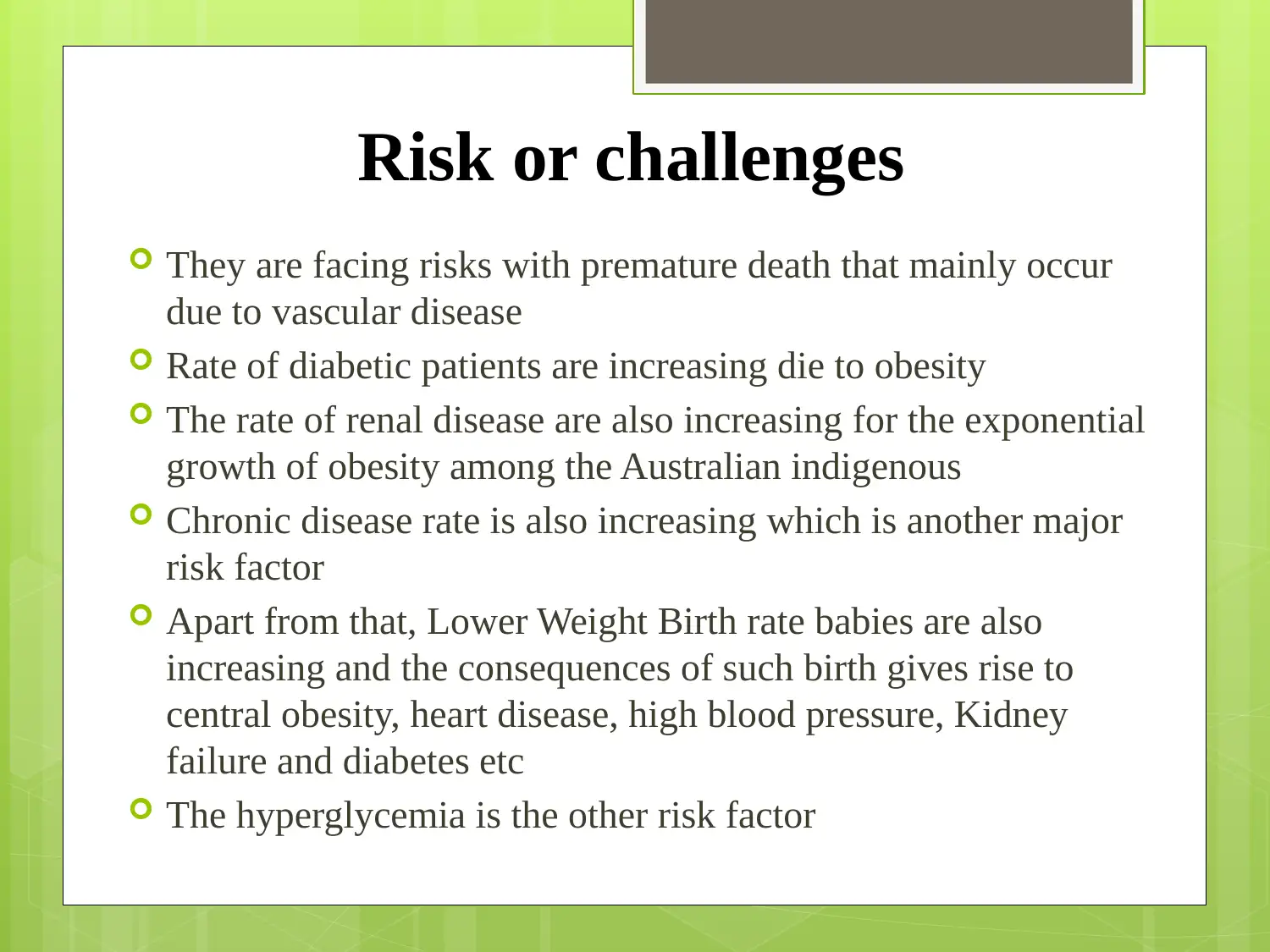
Risk or challenges
They are facing risks with premature death that mainly occur
due to vascular disease
Rate of diabetic patients are increasing die to obesity
The rate of renal disease are also increasing for the exponential
growth of obesity among the Australian indigenous
Chronic disease rate is also increasing which is another major
risk factor
Apart from that, Lower Weight Birth rate babies are also
increasing and the consequences of such birth gives rise to
central obesity, heart disease, high blood pressure, Kidney
failure and diabetes etc
The hyperglycemia is the other risk factor
They are facing risks with premature death that mainly occur
due to vascular disease
Rate of diabetic patients are increasing die to obesity
The rate of renal disease are also increasing for the exponential
growth of obesity among the Australian indigenous
Chronic disease rate is also increasing which is another major
risk factor
Apart from that, Lower Weight Birth rate babies are also
increasing and the consequences of such birth gives rise to
central obesity, heart disease, high blood pressure, Kidney
failure and diabetes etc
The hyperglycemia is the other risk factor
⊘ This is a preview!⊘
Do you want full access?
Subscribe today to unlock all pages.

Trusted by 1+ million students worldwide
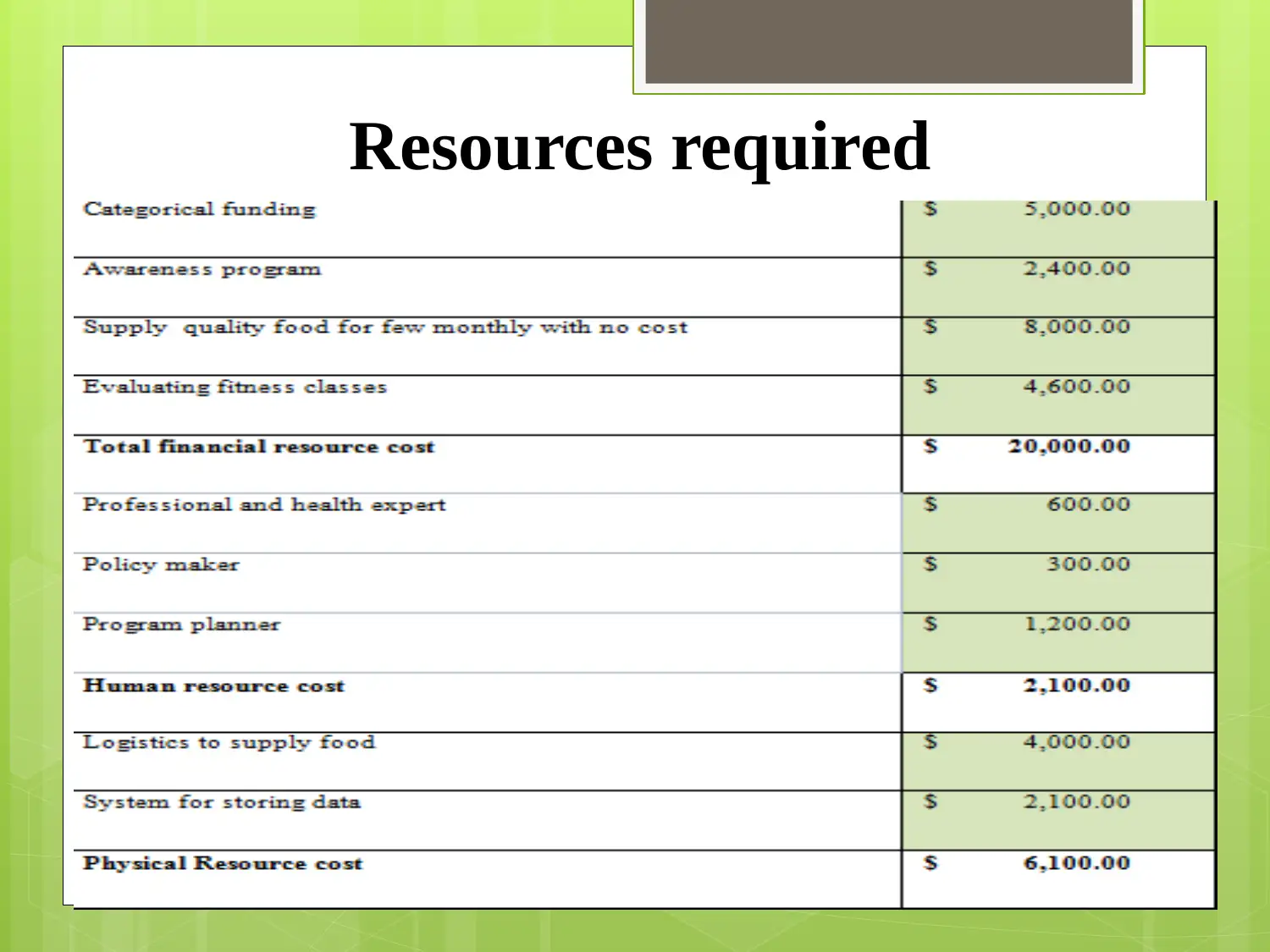
Resources required
Paraphrase This Document
Need a fresh take? Get an instant paraphrase of this document with our AI Paraphraser
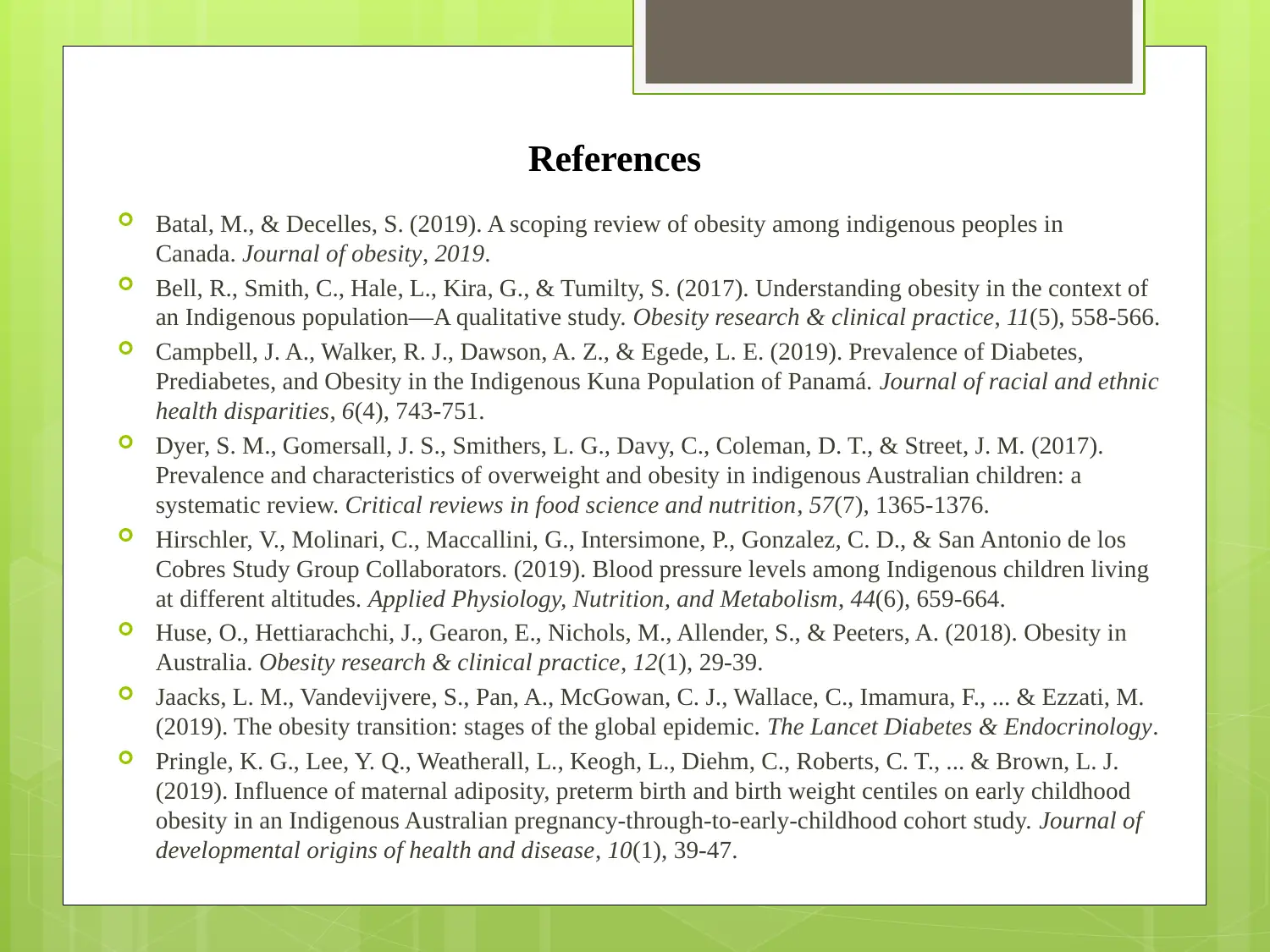
References
Batal, M., & Decelles, S. (2019). A scoping review of obesity among indigenous peoples in
Canada. Journal of obesity, 2019.
Bell, R., Smith, C., Hale, L., Kira, G., & Tumilty, S. (2017). Understanding obesity in the context of
an Indigenous population—A qualitative study. Obesity research & clinical practice, 11(5), 558-566.
Campbell, J. A., Walker, R. J., Dawson, A. Z., & Egede, L. E. (2019). Prevalence of Diabetes,
Prediabetes, and Obesity in the Indigenous Kuna Population of Panamá. Journal of racial and ethnic
health disparities, 6(4), 743-751.
Dyer, S. M., Gomersall, J. S., Smithers, L. G., Davy, C., Coleman, D. T., & Street, J. M. (2017).
Prevalence and characteristics of overweight and obesity in indigenous Australian children: a
systematic review. Critical reviews in food science and nutrition, 57(7), 1365-1376.
Hirschler, V., Molinari, C., Maccallini, G., Intersimone, P., Gonzalez, C. D., & San Antonio de los
Cobres Study Group Collaborators. (2019). Blood pressure levels among Indigenous children living
at different altitudes. Applied Physiology, Nutrition, and Metabolism, 44(6), 659-664.
Huse, O., Hettiarachchi, J., Gearon, E., Nichols, M., Allender, S., & Peeters, A. (2018). Obesity in
Australia. Obesity research & clinical practice, 12(1), 29-39.
Jaacks, L. M., Vandevijvere, S., Pan, A., McGowan, C. J., Wallace, C., Imamura, F., ... & Ezzati, M.
(2019). The obesity transition: stages of the global epidemic. The Lancet Diabetes & Endocrinology.
Pringle, K. G., Lee, Y. Q., Weatherall, L., Keogh, L., Diehm, C., Roberts, C. T., ... & Brown, L. J.
(2019). Influence of maternal adiposity, preterm birth and birth weight centiles on early childhood
obesity in an Indigenous Australian pregnancy-through-to-early-childhood cohort study. Journal of
developmental origins of health and disease, 10(1), 39-47.
Batal, M., & Decelles, S. (2019). A scoping review of obesity among indigenous peoples in
Canada. Journal of obesity, 2019.
Bell, R., Smith, C., Hale, L., Kira, G., & Tumilty, S. (2017). Understanding obesity in the context of
an Indigenous population—A qualitative study. Obesity research & clinical practice, 11(5), 558-566.
Campbell, J. A., Walker, R. J., Dawson, A. Z., & Egede, L. E. (2019). Prevalence of Diabetes,
Prediabetes, and Obesity in the Indigenous Kuna Population of Panamá. Journal of racial and ethnic
health disparities, 6(4), 743-751.
Dyer, S. M., Gomersall, J. S., Smithers, L. G., Davy, C., Coleman, D. T., & Street, J. M. (2017).
Prevalence and characteristics of overweight and obesity in indigenous Australian children: a
systematic review. Critical reviews in food science and nutrition, 57(7), 1365-1376.
Hirschler, V., Molinari, C., Maccallini, G., Intersimone, P., Gonzalez, C. D., & San Antonio de los
Cobres Study Group Collaborators. (2019). Blood pressure levels among Indigenous children living
at different altitudes. Applied Physiology, Nutrition, and Metabolism, 44(6), 659-664.
Huse, O., Hettiarachchi, J., Gearon, E., Nichols, M., Allender, S., & Peeters, A. (2018). Obesity in
Australia. Obesity research & clinical practice, 12(1), 29-39.
Jaacks, L. M., Vandevijvere, S., Pan, A., McGowan, C. J., Wallace, C., Imamura, F., ... & Ezzati, M.
(2019). The obesity transition: stages of the global epidemic. The Lancet Diabetes & Endocrinology.
Pringle, K. G., Lee, Y. Q., Weatherall, L., Keogh, L., Diehm, C., Roberts, C. T., ... & Brown, L. J.
(2019). Influence of maternal adiposity, preterm birth and birth weight centiles on early childhood
obesity in an Indigenous Australian pregnancy-through-to-early-childhood cohort study. Journal of
developmental origins of health and disease, 10(1), 39-47.
1 out of 11
Related Documents
Your All-in-One AI-Powered Toolkit for Academic Success.
+13062052269
info@desklib.com
Available 24*7 on WhatsApp / Email
![[object Object]](/_next/static/media/star-bottom.7253800d.svg)
Unlock your academic potential
Copyright © 2020–2025 A2Z Services. All Rights Reserved. Developed and managed by ZUCOL.





